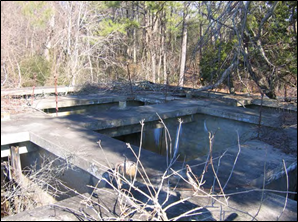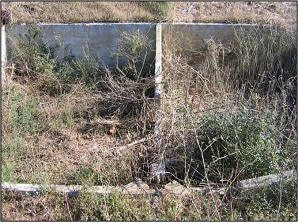Operable Unit 06
Background
Operable Unit 06 (OU 06), Old Wastewater Treatment Plant, also known as Formerly Used Defense Site (FUDS) Project 13, was the first wastewater treatment plant used when the Chincoteague Naval Auxiliary Air Station was established in 1943. The U.S. Army Corps of Engineers (USACE) conducted environmental investigations under the FUDS Program prior to transferring the site to NASA.
History of the Old Wastewater Treatment Plant
The Department of Defense (DoD) established the Chincoteague Naval Auxiliary Air Station (CNAAS) in 1943 at the current Main Base portion of NASA's Wallops Flight Facility (WFF) to establish a training facility for World War II naval aviators. The Navy built three runways, several buildings and supporting infrastructure in the early 1940s, including the Old Wastewater Treatment Plant (WWTP). The Old WWTP was located northwest of the intersection of Runway 17-35 and the abandoned taxiway that parallels Runway 10-28.
 |
| 1943 Aerial Photograph with the Old WWTP |
The Old WWTP included three cinderblock structures and a trickling filter. The cinder-block structures contained a control/pump house, process tanks (chlorine reaction tanks, primary and final settling tanks, and sludge digestion tank), and sludge drying beds. A comminutor building (grinding process) and valve house were located south of the cinderblock structures connected via a 10-inch diameter sewer line.
The Navy built a second WWTP in 1954 and abandoned the Old WWTP in 1955. The DoD decommissioned CNAAS in 1959 and transferred the property to NASA on June 30, 1959. NASA has never used the Old WWTP since the transfer of facility ownership.
Old Wastewater Treatment Plant Site Today
The area surrounding the Old WWTP is approximately 0.8 acres. The site consists of dense vegetation including woodland underbrush and young trees. Most of the Old WWTP structures still exist today. The two sludge drying beds thought to contain residual sludge materials associated with Old WWTP activities are located in the eastern portion of the Old WWTP.
 |
 |
| Former Primary Settling Tank | Former Sludge Drying Beds |
Previous Investigations
NASA first began environmental investigations at WFF in 1990 through a series of facility-wide surveys, inspections, and assessments. In addition to NASA environmental programs at WFF, the United States Army Corps of Engineers (USACE) had an active environmental program at WFF. Some of the areas of concern (AOCs) identified in the initial surveys were identified as being associated with activities that solely took place during DoD ownership. Because of this, USACE, in consultation with NASA and United States Environmental Protection Agency (USEPA), conducted a series of assessments and investigations to determine responsibility and eligibility for these AOCs under the Formerly Used Defense Sites (FUDS) Program. A FUDS is property that was under the jurisdiction, owned, leased, or otherwise possessed by the DoD at the time of actions. USACE conducted several FUDS investigations at WFF starting in 2000.
In 2015, NASA and the DoD, through the Department of the Army, signed a Memorandum of Agreement (MOA) to transfer funds from DoD to NASA to conduct necessary response actions under the Comprehensive Environmental Response, Compensation, and Liability Act (CERCLA). The MOA was authorized by section 315 of the National Defense Authorization Act for Fiscal Year 2015. In 2021, NASA and USEPA entered into an Administrative Agreement and Order on Consent RCRA-03-2021-0022TH (AAOC) for the FUDS Program. The AAOC designated WFF as a Superfund Alternative Approach site.
During cleanup, complex sites may be divided into several distinct areas to make the response more efficient. These areas, called operable units (OUs), may address geographic areas, specific problems, or medium (e.g., groundwater, soil) where a specific action is required. WFF currently has nine OUs. The Old WWTP is designated as OU 6. Below is a summary of the environmental activities at the Old WWTP.
In 1990, NASA completed an Environmental Site Survey, which identified the Old WWTP for further investigation based on a lack of historical data and potential environmental significance.
Multi-Phase Site Investigation – In 1993, NASA conducted Phase 1 of a multi-phase Site Investigation (SI) of the Main Base including an unexploded ordnance (UXO)/magnetometer survey at the Old WWTP. Phase 2 of the SI presented the preliminary findings of a soil gas survey conducted in the vicinity of the Old WWTP. Volatile organic compounds (VOCs) were present in the subsurface soil. The report indicated that additional evaluation of the Old WWTP should be conducted. NASA stopped investigations of the Old WWTP in 1993 after completing the UXO/magnetometer and soil gas surveys because the Site was associated with former Navy activities (prior to 1959) and, therefore, falls under the jurisdiction of the FUDS Program.
Limited SI – In 2003, USACE completed a Limited SI. Arsenic, iron, and silver were detected in surface and shallow subsurface samples that exceeded the human health and/or migration to groundwater screening criteria. Five semi-volatile organic compounds (SVOCs) (four polycyclic aromatic hydrocarbons [PAHs] and one non-PAH SVOC) detected at concentrations above screening criteria. No VOCs were detected at concentrations greater than screening criteria. It was recommended to collect additional soil samples adjacent to or beneath the sludge drying beds to beds to confirm that concentrations exceeding screening criteria do not exist in the subsurface and to collect groundwater samples based upon the potential for contaminants detected in the soil to migrate to the groundwater.
Action Memorandum – In 2006, following the discovery of elemental mercury, USACE issued an Action Memorandum documenting the decision to conduct a time-critical removal action (TCRA) at the Old WWTP trickling filter.
After Action Report – USACE completed the After Action Report for the TCRA. The TCRA included demolition and removal of the trickling filter structure, and recovery of elemental mercury through vacuuming (approximately 7 to 8 pounds). Soil samples collected below the trickling filter did not indicate an impact from the mercury release.
Site Investigation Report – In 2007, USACE completed a Site Investigation (SI). The SI included groundwater, soil, surface water, sediment, and sludge sampling. The SI Report concluded the preliminary human health and ecological risk screening suggested soil, sediment, and surface water did not pose a potential risk. However sludge and groundwater may pose a potential risk to human health and/or ecological receptors.
Remedial Investigation Report – In 2013, USACE completed a Remedial Investigation, which evaluated the sludge drying beds and extent of soil, sediment, groundwater, and surface water contamination, and assessed potential impacts to human health and the environment. Contaminants identified in the Old WWTP sludge, which include chromium, mercury, dichlorodiphenyldichloroethane (DDD), dichlorodiphenyldichloroethylene (DDE), pose an unacceptable ecological risk to birds and mammals (American robin and short-tailed shrew) that feed on soil invertebrates.
Focused Feasibility Study Report – In 2015, USACE completed the Focused Feasibility Study (FFS). The FFS evaluated remedial alternatives including Land Use Controls, Low-Permeability Cap Installation, and Sludge Removal and Off-Site Disposal.
Record of Decision
In 2023, NASA and EPA completed the Record of Decision documenting the selected remedy of Sludge Removal and Off-Site Disposal. The Virginia Department of Environmental Quality concurred with the selected remedy.
In 2022, NASA completed the Proposed Plan, which identified Sludge Removal and Off-Site Disposal as the preferred remedial alternative and final remedy for the soil, sludge, sediment, and surface water. Contaminants in groundwater will be addressed in the FUDS Project 11 Main Base Remedial Investigation and NASA's ongoing investigations for per- and polyfluoroalkyl substances (PFAS).
In addition, NASA, the U.S. Environmental Protection Agency, and Virginia Department of Environmental Quality held a public information session on August 24, 2022, to discuss the Proposed Plan at the NASA WFF Visitors Center.
For any questions regarding Operable Unit 06, please contact:
Kristi Francisco
Restoration Project Manager
NASA Wallops Flight Facility
Mailstop: 250.W
Wallops Island, VA 23337
kristi.l.francisco@nasa.gov
757-824-6704



